Post by Antonio on Feb 28, 2022 16:27:40 GMT 12
Link: airandspace.si.edu/stories/editorial/better-propellers-few-desmond-cookes-legacy-battle-britain
75TH ANNIVERSARY OF WORLD WAR II
Better Propellers for “The Few”: Desmond Cooke’s Legacy in the Battle of Britain
Posted on Jul 10, 2020
By: Jeremy Kinney
During the early afternoon of Tuesday, August 13, 1940, Royal Air Force Flight Lt. Gordon Olive and the pilots of 65 Squadron patrolled the skies over the English Channel near Dover in their Spitfire fighters. They met approximately 20 Messerschmitt Bf 109s at about 19,000 feet. Afterwards, Olive saw four more Bf 109s at 23,000 feet, and he climbed to meet them, promptly shooting down one Messerschmitt before the other three dove for the safety of France. Seeing an additional four Bf 109s at 26,000 feet, Olive climbed once again, positioning himself above them and “down sun,” with the sun at his back and in the eyes of his targets, to gain the advantage of surprise. He destroyed another Bf 109, but that wasn’t the end of the fight. As Olive started to rejoin 65 Squadron, 30 Bf 109s attacked him in level flight. Olive climbed above them into the sun and boldly attacked the nearest fighter. Sent into disarray, the Messerschmitt formation broke up. Olive pursued a lone Bf 109 headed toward France, expending the rest of the ammunition from his eight Browning machine guns before the Bf 109 disappeared into the protection of a cloud. Over the course of one mission, Olive successfully took on superior numbers of fighters all by himself in three consecutive encounters, out-climbed them, and shot down two and perhaps a third.

Paul Nash’s Battle of Britain (1941) evokes the danger the pilots of RAF Fighter Command faced in the skies over England where they needed every performance advantage to overcome the Nazi Luftwaffe. (© IWM Art. IWM ART LD 1550)
Just two months before, Olive’s Spitfire, as well as the others flown by Fighter Command of the Royal Air Force (RAF), struggled in combat against the Luftwaffe’s premiere fighter, the Bf 109. So what changed? A modification of his propeller to constant-speed operation enhanced the performance of his Spitfire at all altitudes and conditions. The upgrade enabled the changing of blade angle, or pitch, automatically according to varying flight conditions while the engine speed remained the same, maximizing propeller, engine, and fuel economy and offering hands-off operation in combat. Olive’s commanding officer and fellow Spitfire pilot, Squadron Leader Desmond Cooke, was the driving force behind the conversion of the now-legendary Supermarine Spitfire and Hawker Hurricane fighters of 1940 to constant-speed operation. That work contributed to Fighter Command’s momentous victory in the Battle of Britain, which raged from July 10 to October 31, 1940.
Desmond de Lancey Cooke was born on June 28, 1907, to Harry de Lancey and Dorothy Cooke in George Town, Penang, which was part of the British Straits Settlements colony on the Malayan Peninsula, where his father was a civil servant. After returning to England, he attended Windlesham House School and Brighton College where he excelled at swimming. He entered the RAF College at Cranwell in 1925 and received a permanent commission in July 1927 upon his graduation. After flying assignments in England, India, and the Middle East, he took over 65 Squadron in October 1937 and rose to the rank of Squadron Leader the following April. As the leader of one of the RAF’s main fighter squadrons, Cooke led his pilots flying Gloster Gladiator biplane fighters. They affectionately called him “Cookie” or “Des.”

Officers of 65 Squadron stand in front of a Gloster fighter at RAF Hornchurch in 1937. Squadron Leader Cooke is fourth from left.
65 Squadron became the fourth RAF unit to receive Supermarine Spitfire Mark I fighters in late March 1939. Their Spitfires had three blade two-pitch propellers with lightweight aluminum alloy blades, which were licensed built versions of American Hamilton Standard designs manufactured by de Havilland Aircraft. The “DH” propeller offered two blade angles, or pitch settings, for takeoff and cruise, offering more performance than the wooden, two-blade fixed-pitch propellers that were on the first 77 Spitfires.
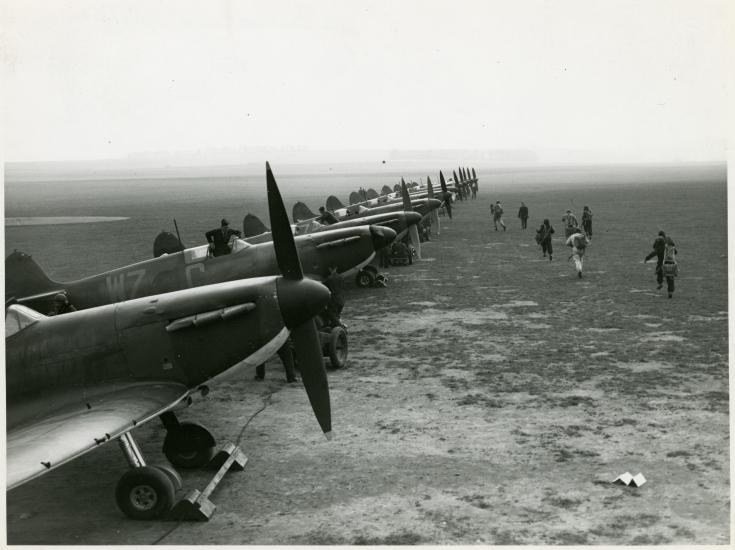
RAF Fighter Command’s 19 Squadron received its new Spitfire fighters equipped with two-blade Airscrew Company fixed-pitch propellers in August 1938.
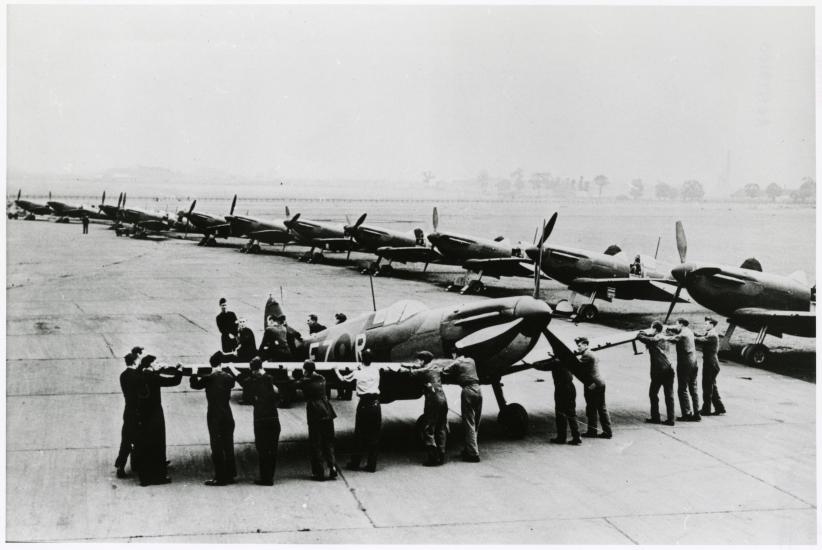
65 Squadron received its Spitfires equipped with de Havilland three-blade two-pitch propellers in March 1939. Their Spitfires are being repositioned at Hornchurch during the summer of 1939. The squadron code on their fuselages changed from “FZ” to “YT” at the outbreak of World War II to confuse German intelligence.

Two sections of 65 Squadron Spitfires flying a step down formation over England in 1939. The squadron code on their fuselages changed from “FZ” to “YT” at the outbreak of World War II to confuse German intelligence.
(Note: I believe that Robert Stanford Tuck (Flt Lt?) is flying FZ-L)
After the outbreak of World War II, 65 Squadron and other Spitfire units began to clash with the Luftwaffe, especially during the Dunkirk evacuation in late May and early June 1940. They realized they were operating at a serious disadvantage with their two-pitch propellers. The Bf 109 had a higher operational ceiling, able to fly as high as 30,000 feet, and a clear advantage in acceleration, rate of climb, and power diving due to its VDM constant-speed propeller. Changing from takeoff to cruise as the Spitfire climbed was equivalent to changing from bottom to top gear in a small four speed car, which meant the engine was under strain and underpowered during a crucial and vulnerable moment in the air. If a Bf 109 pilot wanted to dive to escape another fighter, all he had to do was zoom away. A Spitfire pilot had to throttle his engine back in a dive to avoid over-revving his engine if he pursued his quarry. The consensus gathered by de Havilland engineers and test pilots in contact with Fighter Command was that a constant-speed propeller was needed.
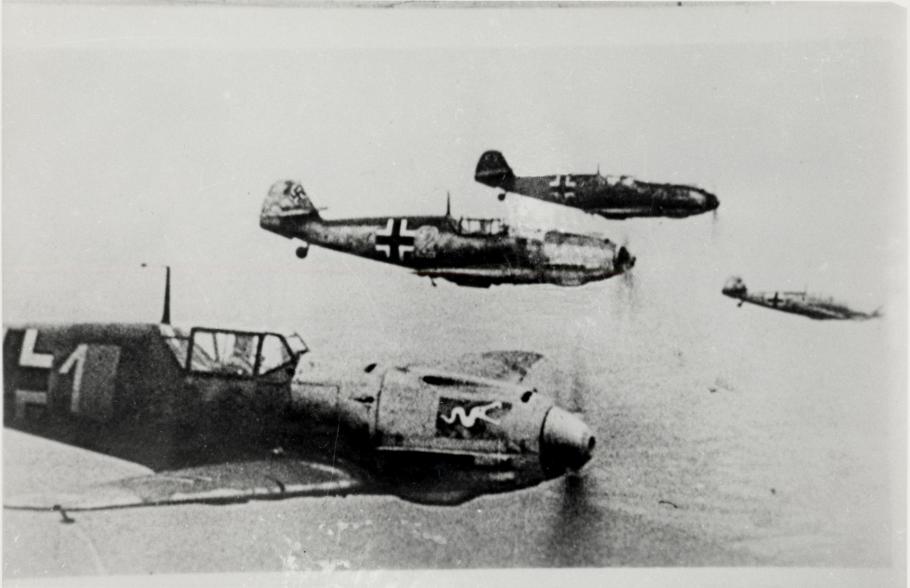
Messerschmitt Bf 109E fighters flying over the English Channel in the 1940-1941 period.
There were already some Spitfire and Hurricane fighters equipped with constant-speed propellers, but they were not available for all. Ongoing service trials of the Rotol propeller by 54 Squadron and pilots from other squadrons, including Cooke, confirmed Fighter Command’s belief in the superiority of constant-speed propellers. Unfortunately, Rotol would not be ready for volume production until August, when the giant shadow factory at Castle Bromwich would be producing the next variant of the Spitfire, the Mark II. New Hurricanes delivered by Hawker and other manufacturers continued to be equipped with Rotol propellers when they were available. For the immediate future, the majority of operational Spitfire and Hurricane units had to make do with the DH two-pitch propeller.
Undeterred, Cooke pushed to improve the performance of the Spitfire as 65 Squadron flew from Hornchurch, a central RAF fighter station northeast of London. It was well-known that the addition of a speed-regulating device called a governor to the DH propeller converted it from two-pitch operation to constant-speed. An unknown engineering officer from Hornchurch—possibly Flight Lt. McGrath from 65 Squadron under orders from Cooke—contacted de Havilland directly by telephone on Sunday, June 9. He asked if the company could perform a sample conversion on a Spitfire “without a lot of paperwork and fuss.” De Havilland agreed and immediately went to work gathering the personnel and components needed for the trial. Beginning on June 13, a crew of de Havilland specialists worked 36 hours nonstop to convert a Spitfire for evaluation by Fighter Command.
The converted DH constant-speed fighter Spitfire arrived at Hornchurch on June 15. Squadron Leader Cooke and the pilots of 65 Squadron conducted the flying evaluations with de Havilland test pilot Eric Lane-Burslem. The modified Spitfire could take off in 225 yards, instead of 320 yards; could climb to 20,000 feet in 7 minutes 42 seconds, instead of 11 minutes 8 seconds; could fly as high as 39,000, instead of just 32,000 feet; and had improved maneuverability. The converted Spitfire flown by 65 Squadron generated a performance improvement equal to those demonstrated by 54 Squadron’s Rotol-equipped Spitfires.
Cooke went through official channels to recommend a service-wide conversion program. On June 17, Fighter Command forwarded the results of the Hornchurch comparative tests along with Cooke’s recommendations to the government department responsible for the RAF, the Air Ministry. While waiting on the official response, Cooke had the de Havilland technicians convert his personal Spitfire on Thursday, June 20. The following day, he led his squadron of two-pitch Spitfires on a combat patrol over France against the Luftwaffe.
The Air Ministry instructed de Havilland via telephone to convert all Spitfires, Hurricanes, and Boulton Paul Defiants from two-pitch to constant-speed on Saturday, June 22, the same day France signed its armistice agreement with Nazi Germany. The work was to take precedence over all other existing contracts with the immediate focus placed on Fighter Command’s Spitfires. De Havilland engineers started the conversion program at 12 Spitfire stations on Tuesday, June 25.
The next day, the pilots of 609 Squadron, based at Northolt west of London, were enjoying a lull in operations. Out of nowhere and without prior notice, a team of de Havilland engineers arrived at the fighter station by car. The team finished one Spitfire that evening, and it took to the air. Weary from the Dunkirk campaign where they had lost one-third of their comrades over the course of just three days, 609 Squadron was elated and amazed by the performance of the converted Spitfire. Their general consensus, recorded in the squadron’s operational record book, was that “the Spitfire now ‘is an aeroplane.’”

Camera gun film from a 609 Squadron Spitfire hitting a Luftwaffe Heinkel He 111 bomber on September 25, 1940. (© IWM CH 1823)
As the conversion program continued across England, the pilots of 65 Squadron took their improved Spitfires into the air where they learned that fighting the Luftwaffe was still a deadly matter. The six Spitfires of “B” flight, divided into Blue and Green sections, left Hornchurch at just after 8 pm on July 7, 1940, to intercept enemy raiders over the English Channel at 8,000 feet. As they positioned themselves to attack, Green section, consisting of Flying Officer George V. Proudman, Pilot Officer Norman J. Brisbane, and Sgt. Patrick S. Hayes, dove toward their targets, disappeared from view, and were later reported as missing in action and presumed lost over the Channel. Blue section turned to meet half a dozen Bf 109s that dove on them from the rear and engaged in individual combat. Flight Sgt. William H. Franklin claimed two Bf 109s and Flight Lt. Gerald A.W. Saunders one. Blue section survived the attack, engaged their adversaries, and escaped repeated attacks before returning to Hornchurch. The squadron’s intelligence officer noted in his account of Blue section’s encounter that “our pilots report that due to the new DH constant speed airscrews, they were able to out-maneuver enemy aircraft in every instance.”
The following day, Monday, July 8, Cooke led 65 Squadron to intercept Luftwaffe raiders over Dover around 3:30 pm in the afternoon. It was to be his last mission before stepping down from command of the squadron in anticipation of a well-deserved promotion to Wing Commander. They spotted several Bf 109s and “Cookie” ordered his pilots to attack. During the ensuing melee where 65 Squadron pilots claimed two Bf 109s, Cooke led the two aircraft of his section into a large cloud. When they re-emerged into the open, Cooke and his Spitfire were gone, never to be seen or heard from again. Shaken by the loss of their leader, 65 Squadron continued on in their aerial struggle against the Luftwaffe. Unbeknownst to them, Bf 109 pilot Josef Fözö of Jagdgeschwader 51 claimed Cooke as his fifth aerial victory.
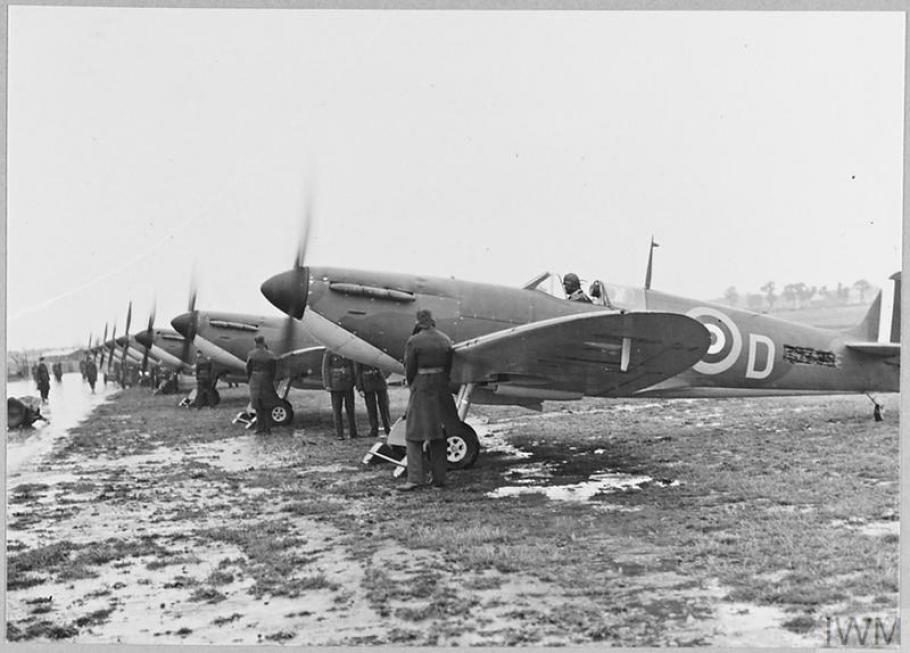
65 Squadron received eight new Spitfires through the sponsorship of the East India Fund in July 1940. These new Spitfires featured de Havilland constant-speed propellers. (© IWM CH 594)
(Great to see a water-logged airfield. Most photos show dry ones)
The Battle of Britain began on July 10. Throughout the rest of the month and into August, the RAF and the Luftwaffe dueled high over the English coast. On August 2, all Fighter Command Spitfires, numbering approximately 300 serviceable aircraft, were capable of constant-speed operation. The conversion teams continued their focus on the remaining Hurricane and Defiant fighters while de Havilland switched to direct production for the Supermarine and Hurricane assembly lines. By August 16, 1,051 Spitfires and Hurricanes had been converted to constant-speed operation. Fighter Command pilots used the new technology in combat as the Battle of Britain raged on into October.
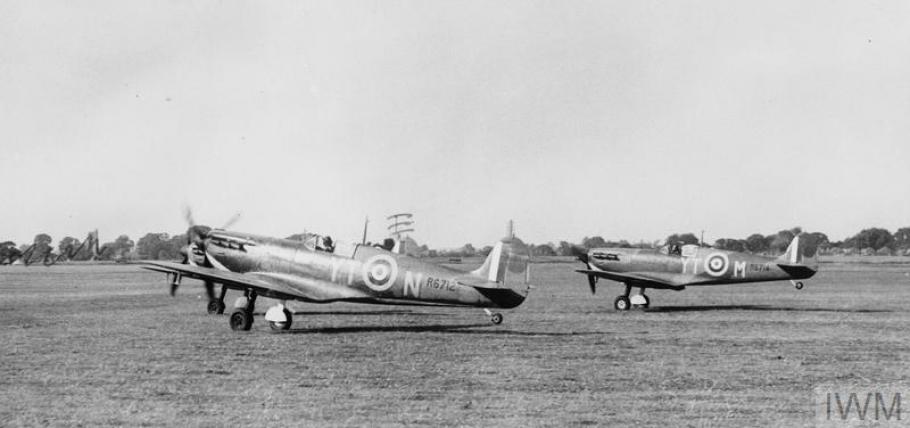
Constant-speed-equipped Spitfires of 65 Squadron taking off in August 1940. (© IWM HU 54421)
The loss of Desmond Cooke is symbolic of the many tragedies caused by war. The RAF lost an experienced, respected, and admired leader that possessed the knowledge and creativity to find solutions to critical problems. His fiancé, Valerie Cynthia O’Shea, lost him just three days before their wedding. His mother, Dorothy, widowed a few years before, had no other children and was left living alone in Cyprus as the sole survivor of the Cooke family. Unfortunately, there is no photographic evidence of Cooke in 1940 with the exception of images believed to be of him with 65 Squadron pilots, in the cockpit, and sitting in the Spitfire (serial number K9907) that he was flying on July 8.
Since Cooke disappeared two days before the RAF’s recognized beginning of the Battle of Britain on July 10, he is not counted among the almost 3,000 British and Allied airmen that fought in the battle and were celebrated by Prime Minister Winston Churchill as “The Few.” But he is listed among the over 20,000 RAF personnel lost over the United Kingdom and Europe that have no known graves and are recognized at the Air Forces Memorial at Runnymede in Surrey in southeast England. Cooke’s official combat tally as a fighter pilot was two aircraft destroyed and one shared.
In the grand scheme of World War II, the contributions of engineering- and performance-minded fighter pilots such as Desmond Cooke were not just combat victories. His achievement was ensuring that his fellow Fighter Command pilots had the best equipment available in the hope that Great Britain would prevail in the rapidly unfolding and great struggle ahead. For him, the survival of his nation depended on better propellers.
Jeremy R. Kinney discovered the story of Desmond Cooke while writing his book Reinventing the Propeller: Aeronautical Specialty and the Triumph of the Modern Airplane. He would like to thank Christer Bergström, James Harrison, Tom Pearson-Chisman, Michael Taylor, Mike Williams, and the Hornchurch Aerodrome Historical Trust for their assistance in writing this blog.
75TH ANNIVERSARY OF WORLD WAR II
Better Propellers for “The Few”: Desmond Cooke’s Legacy in the Battle of Britain
Posted on Jul 10, 2020
By: Jeremy Kinney
During the early afternoon of Tuesday, August 13, 1940, Royal Air Force Flight Lt. Gordon Olive and the pilots of 65 Squadron patrolled the skies over the English Channel near Dover in their Spitfire fighters. They met approximately 20 Messerschmitt Bf 109s at about 19,000 feet. Afterwards, Olive saw four more Bf 109s at 23,000 feet, and he climbed to meet them, promptly shooting down one Messerschmitt before the other three dove for the safety of France. Seeing an additional four Bf 109s at 26,000 feet, Olive climbed once again, positioning himself above them and “down sun,” with the sun at his back and in the eyes of his targets, to gain the advantage of surprise. He destroyed another Bf 109, but that wasn’t the end of the fight. As Olive started to rejoin 65 Squadron, 30 Bf 109s attacked him in level flight. Olive climbed above them into the sun and boldly attacked the nearest fighter. Sent into disarray, the Messerschmitt formation broke up. Olive pursued a lone Bf 109 headed toward France, expending the rest of the ammunition from his eight Browning machine guns before the Bf 109 disappeared into the protection of a cloud. Over the course of one mission, Olive successfully took on superior numbers of fighters all by himself in three consecutive encounters, out-climbed them, and shot down two and perhaps a third.

Paul Nash’s Battle of Britain (1941) evokes the danger the pilots of RAF Fighter Command faced in the skies over England where they needed every performance advantage to overcome the Nazi Luftwaffe. (© IWM Art. IWM ART LD 1550)
Just two months before, Olive’s Spitfire, as well as the others flown by Fighter Command of the Royal Air Force (RAF), struggled in combat against the Luftwaffe’s premiere fighter, the Bf 109. So what changed? A modification of his propeller to constant-speed operation enhanced the performance of his Spitfire at all altitudes and conditions. The upgrade enabled the changing of blade angle, or pitch, automatically according to varying flight conditions while the engine speed remained the same, maximizing propeller, engine, and fuel economy and offering hands-off operation in combat. Olive’s commanding officer and fellow Spitfire pilot, Squadron Leader Desmond Cooke, was the driving force behind the conversion of the now-legendary Supermarine Spitfire and Hawker Hurricane fighters of 1940 to constant-speed operation. That work contributed to Fighter Command’s momentous victory in the Battle of Britain, which raged from July 10 to October 31, 1940.
Desmond de Lancey Cooke was born on June 28, 1907, to Harry de Lancey and Dorothy Cooke in George Town, Penang, which was part of the British Straits Settlements colony on the Malayan Peninsula, where his father was a civil servant. After returning to England, he attended Windlesham House School and Brighton College where he excelled at swimming. He entered the RAF College at Cranwell in 1925 and received a permanent commission in July 1927 upon his graduation. After flying assignments in England, India, and the Middle East, he took over 65 Squadron in October 1937 and rose to the rank of Squadron Leader the following April. As the leader of one of the RAF’s main fighter squadrons, Cooke led his pilots flying Gloster Gladiator biplane fighters. They affectionately called him “Cookie” or “Des.”

Officers of 65 Squadron stand in front of a Gloster fighter at RAF Hornchurch in 1937. Squadron Leader Cooke is fourth from left.
65 Squadron became the fourth RAF unit to receive Supermarine Spitfire Mark I fighters in late March 1939. Their Spitfires had three blade two-pitch propellers with lightweight aluminum alloy blades, which were licensed built versions of American Hamilton Standard designs manufactured by de Havilland Aircraft. The “DH” propeller offered two blade angles, or pitch settings, for takeoff and cruise, offering more performance than the wooden, two-blade fixed-pitch propellers that were on the first 77 Spitfires.

RAF Fighter Command’s 19 Squadron received its new Spitfire fighters equipped with two-blade Airscrew Company fixed-pitch propellers in August 1938.

65 Squadron received its Spitfires equipped with de Havilland three-blade two-pitch propellers in March 1939. Their Spitfires are being repositioned at Hornchurch during the summer of 1939. The squadron code on their fuselages changed from “FZ” to “YT” at the outbreak of World War II to confuse German intelligence.

Two sections of 65 Squadron Spitfires flying a step down formation over England in 1939. The squadron code on their fuselages changed from “FZ” to “YT” at the outbreak of World War II to confuse German intelligence.
(Note: I believe that Robert Stanford Tuck (Flt Lt?) is flying FZ-L)
After the outbreak of World War II, 65 Squadron and other Spitfire units began to clash with the Luftwaffe, especially during the Dunkirk evacuation in late May and early June 1940. They realized they were operating at a serious disadvantage with their two-pitch propellers. The Bf 109 had a higher operational ceiling, able to fly as high as 30,000 feet, and a clear advantage in acceleration, rate of climb, and power diving due to its VDM constant-speed propeller. Changing from takeoff to cruise as the Spitfire climbed was equivalent to changing from bottom to top gear in a small four speed car, which meant the engine was under strain and underpowered during a crucial and vulnerable moment in the air. If a Bf 109 pilot wanted to dive to escape another fighter, all he had to do was zoom away. A Spitfire pilot had to throttle his engine back in a dive to avoid over-revving his engine if he pursued his quarry. The consensus gathered by de Havilland engineers and test pilots in contact with Fighter Command was that a constant-speed propeller was needed.

Messerschmitt Bf 109E fighters flying over the English Channel in the 1940-1941 period.
There were already some Spitfire and Hurricane fighters equipped with constant-speed propellers, but they were not available for all. Ongoing service trials of the Rotol propeller by 54 Squadron and pilots from other squadrons, including Cooke, confirmed Fighter Command’s belief in the superiority of constant-speed propellers. Unfortunately, Rotol would not be ready for volume production until August, when the giant shadow factory at Castle Bromwich would be producing the next variant of the Spitfire, the Mark II. New Hurricanes delivered by Hawker and other manufacturers continued to be equipped with Rotol propellers when they were available. For the immediate future, the majority of operational Spitfire and Hurricane units had to make do with the DH two-pitch propeller.
Undeterred, Cooke pushed to improve the performance of the Spitfire as 65 Squadron flew from Hornchurch, a central RAF fighter station northeast of London. It was well-known that the addition of a speed-regulating device called a governor to the DH propeller converted it from two-pitch operation to constant-speed. An unknown engineering officer from Hornchurch—possibly Flight Lt. McGrath from 65 Squadron under orders from Cooke—contacted de Havilland directly by telephone on Sunday, June 9. He asked if the company could perform a sample conversion on a Spitfire “without a lot of paperwork and fuss.” De Havilland agreed and immediately went to work gathering the personnel and components needed for the trial. Beginning on June 13, a crew of de Havilland specialists worked 36 hours nonstop to convert a Spitfire for evaluation by Fighter Command.
The converted DH constant-speed fighter Spitfire arrived at Hornchurch on June 15. Squadron Leader Cooke and the pilots of 65 Squadron conducted the flying evaluations with de Havilland test pilot Eric Lane-Burslem. The modified Spitfire could take off in 225 yards, instead of 320 yards; could climb to 20,000 feet in 7 minutes 42 seconds, instead of 11 minutes 8 seconds; could fly as high as 39,000, instead of just 32,000 feet; and had improved maneuverability. The converted Spitfire flown by 65 Squadron generated a performance improvement equal to those demonstrated by 54 Squadron’s Rotol-equipped Spitfires.
Cooke went through official channels to recommend a service-wide conversion program. On June 17, Fighter Command forwarded the results of the Hornchurch comparative tests along with Cooke’s recommendations to the government department responsible for the RAF, the Air Ministry. While waiting on the official response, Cooke had the de Havilland technicians convert his personal Spitfire on Thursday, June 20. The following day, he led his squadron of two-pitch Spitfires on a combat patrol over France against the Luftwaffe.
The Air Ministry instructed de Havilland via telephone to convert all Spitfires, Hurricanes, and Boulton Paul Defiants from two-pitch to constant-speed on Saturday, June 22, the same day France signed its armistice agreement with Nazi Germany. The work was to take precedence over all other existing contracts with the immediate focus placed on Fighter Command’s Spitfires. De Havilland engineers started the conversion program at 12 Spitfire stations on Tuesday, June 25.
The next day, the pilots of 609 Squadron, based at Northolt west of London, were enjoying a lull in operations. Out of nowhere and without prior notice, a team of de Havilland engineers arrived at the fighter station by car. The team finished one Spitfire that evening, and it took to the air. Weary from the Dunkirk campaign where they had lost one-third of their comrades over the course of just three days, 609 Squadron was elated and amazed by the performance of the converted Spitfire. Their general consensus, recorded in the squadron’s operational record book, was that “the Spitfire now ‘is an aeroplane.’”

Camera gun film from a 609 Squadron Spitfire hitting a Luftwaffe Heinkel He 111 bomber on September 25, 1940. (© IWM CH 1823)
As the conversion program continued across England, the pilots of 65 Squadron took their improved Spitfires into the air where they learned that fighting the Luftwaffe was still a deadly matter. The six Spitfires of “B” flight, divided into Blue and Green sections, left Hornchurch at just after 8 pm on July 7, 1940, to intercept enemy raiders over the English Channel at 8,000 feet. As they positioned themselves to attack, Green section, consisting of Flying Officer George V. Proudman, Pilot Officer Norman J. Brisbane, and Sgt. Patrick S. Hayes, dove toward their targets, disappeared from view, and were later reported as missing in action and presumed lost over the Channel. Blue section turned to meet half a dozen Bf 109s that dove on them from the rear and engaged in individual combat. Flight Sgt. William H. Franklin claimed two Bf 109s and Flight Lt. Gerald A.W. Saunders one. Blue section survived the attack, engaged their adversaries, and escaped repeated attacks before returning to Hornchurch. The squadron’s intelligence officer noted in his account of Blue section’s encounter that “our pilots report that due to the new DH constant speed airscrews, they were able to out-maneuver enemy aircraft in every instance.”
The following day, Monday, July 8, Cooke led 65 Squadron to intercept Luftwaffe raiders over Dover around 3:30 pm in the afternoon. It was to be his last mission before stepping down from command of the squadron in anticipation of a well-deserved promotion to Wing Commander. They spotted several Bf 109s and “Cookie” ordered his pilots to attack. During the ensuing melee where 65 Squadron pilots claimed two Bf 109s, Cooke led the two aircraft of his section into a large cloud. When they re-emerged into the open, Cooke and his Spitfire were gone, never to be seen or heard from again. Shaken by the loss of their leader, 65 Squadron continued on in their aerial struggle against the Luftwaffe. Unbeknownst to them, Bf 109 pilot Josef Fözö of Jagdgeschwader 51 claimed Cooke as his fifth aerial victory.

65 Squadron received eight new Spitfires through the sponsorship of the East India Fund in July 1940. These new Spitfires featured de Havilland constant-speed propellers. (© IWM CH 594)
(Great to see a water-logged airfield. Most photos show dry ones)
The Battle of Britain began on July 10. Throughout the rest of the month and into August, the RAF and the Luftwaffe dueled high over the English coast. On August 2, all Fighter Command Spitfires, numbering approximately 300 serviceable aircraft, were capable of constant-speed operation. The conversion teams continued their focus on the remaining Hurricane and Defiant fighters while de Havilland switched to direct production for the Supermarine and Hurricane assembly lines. By August 16, 1,051 Spitfires and Hurricanes had been converted to constant-speed operation. Fighter Command pilots used the new technology in combat as the Battle of Britain raged on into October.

Constant-speed-equipped Spitfires of 65 Squadron taking off in August 1940. (© IWM HU 54421)
The loss of Desmond Cooke is symbolic of the many tragedies caused by war. The RAF lost an experienced, respected, and admired leader that possessed the knowledge and creativity to find solutions to critical problems. His fiancé, Valerie Cynthia O’Shea, lost him just three days before their wedding. His mother, Dorothy, widowed a few years before, had no other children and was left living alone in Cyprus as the sole survivor of the Cooke family. Unfortunately, there is no photographic evidence of Cooke in 1940 with the exception of images believed to be of him with 65 Squadron pilots, in the cockpit, and sitting in the Spitfire (serial number K9907) that he was flying on July 8.
Since Cooke disappeared two days before the RAF’s recognized beginning of the Battle of Britain on July 10, he is not counted among the almost 3,000 British and Allied airmen that fought in the battle and were celebrated by Prime Minister Winston Churchill as “The Few.” But he is listed among the over 20,000 RAF personnel lost over the United Kingdom and Europe that have no known graves and are recognized at the Air Forces Memorial at Runnymede in Surrey in southeast England. Cooke’s official combat tally as a fighter pilot was two aircraft destroyed and one shared.
In the grand scheme of World War II, the contributions of engineering- and performance-minded fighter pilots such as Desmond Cooke were not just combat victories. His achievement was ensuring that his fellow Fighter Command pilots had the best equipment available in the hope that Great Britain would prevail in the rapidly unfolding and great struggle ahead. For him, the survival of his nation depended on better propellers.
Jeremy R. Kinney discovered the story of Desmond Cooke while writing his book Reinventing the Propeller: Aeronautical Specialty and the Triumph of the Modern Airplane. He would like to thank Christer Bergström, James Harrison, Tom Pearson-Chisman, Michael Taylor, Mike Williams, and the Hornchurch Aerodrome Historical Trust for their assistance in writing this blog.

